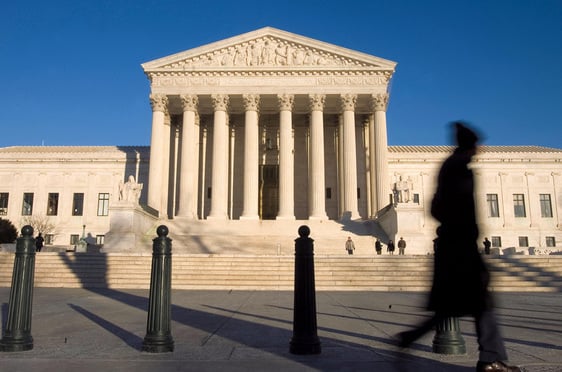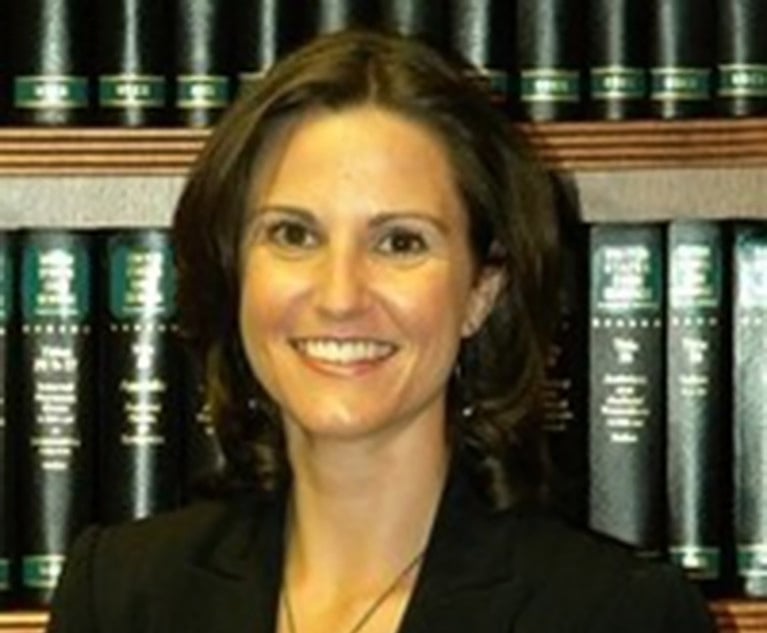The Supreme Court Takes Aim at Deference to Administrative Agencies
'Kisor' is just one example of current members of the court attacking established rules of statutory and regulatory construction.
April 05, 2019 at 03:00 PM
7 minute read
 Supreme Court building. February 7, 2007. Credit: Diego M. Radzinschi/LEGAL TIMES.
Supreme Court building. February 7, 2007. Credit: Diego M. Radzinschi/LEGAL TIMES.
In 1989, the late Justice Antonin Scalia authored one of the seminal opinions on deference to administrative agencies. In Auer v. Robbins, 519 U.S. 452 (1997), he famously reaffirmed a long-standing rule of administrative deference dating back to Bowles v. Seminole Rock & Sand Co., 325 U.S. 410 (1945): When the meaning of an administrative regulation is in doubt, the agency's interpretation of the regulation is “controlling unless plainly erroneous or inconsistent with the regulation.” Id. (internal quotations omitted). Deference will be given even to informal interpretations that are not adopted through rulemaking or formal adjudication under the Administrative Procedure Act (APA). By 2011, however, Justice Scalia had made an about-face: “[W]hile I have in the past uncritically accepted [the Auer] rule, I have become increasingly doubtful of its validity.” Talk Am., Inc. v. Mich. Bell Tel. Co., 564 U.S. 50, 68 (2011) (Scalia, J., concurring).
Justice Scalia's doubts seem to have gained traction with the conservative Justices on the court. On March 27, 2019, the court heard argument in Kisor v. Wilkie, Case No. 18-15, a case that asks if the court should overrule Auer and Seminole Rock.
Undoubtedly, there are valid criticisms of how courts employ these cases. Critics of Auer deference maintain that deferring to agency interpretations of its own regulations: (1) gives administrative agencies incentive to promulgate vague regulations, thereby giving the agency maximum flexibility to issue later, informal interpretations; (2) permits agencies to evade the requirements of the Administrative Procedure Act's rulemaking and formal adjudication procedures; (3) makes it easier for agencies to change their interpretations, particularly when new administrations take office; and (4) violate separation of powers by effectively giving administrative agencies the power to create and interpret the law.
Auer's defenders counter that these criticisms are overblown. They argue that Auer deference encourages agencies to be specific in regulations to prevent subsequent administrations from reversing course; that it is inefficient and impractical to require formal rulemaking or adjudication for every interpretation of a regulation; that the ability of agencies to change positions is limited by the language of regulations and the statutes they interpret; and that courts reject arbitrary changes in interpretation, including changes that upset interests that relied on previous interpretations and that are not adequately explained.
Kisor is just one example of current members of the court attacking established rules of statutory and regulatory construction. Last year, Justice Clarence Thomas, joined by Justices Samuel Alito and Neil Gorsuch, criticized the majority's reliance on legislative history materials—a committee report—to interpret a federal statute in Digital Realty Trust v. Somers, — U.S. –, 138 S.Ct. 767, 783-84 (2018) (Thomas, J. concurring). Several Justices, including Justices Thomas, Gorsuch, and Brett Kavanaugh, as well as former Justice Anthony Kennedy, have expressed doubts about the continuing application of Chevron U.S.A. v. Natural Resources Defense Council, 467 U.S. 837 (1984), so-called Chevron deference, which requires courts to defer to “reasonable” agency interpretations of statutes.
Overlooked in the criticisms is a pragmatic concern. Rules governing how to interpret statutes and regulations are critically important. While appellate litigators focus on such rules because they play a major role in any brief centered on statutory and regulatory interpretation, the rules of construction help everyone predict the outcome of a dispute over the meaning of a law. Thus, an employer uncertain about the meaning of a recent Department of Labor regulation governing the calculation of wages can rely on an interpretive bulletin that details how the calculation should be made. Knowing that the interpretive bulletin is likely to be the tie-breaker in a wage dispute provides more certainty than being forced to wait for a court to interpret the regulation in the future.
The critics of Auer and the other rules of construction often maintain that the rules give administrative agencies too much power and take away the power of interpretation from the courts. That argument misses three salient points.
First, administrative agencies are given deference because of their perceived expertise in a field, e.g., labor and employment, transportation, financial oversight, etc. Judges without such expertise may overlook important considerations.
Second, it is not feasible to expect that courts through litigation will handle the sheer volume of interpretations that administrative agencies must issue. It is impossible for agencies to fully anticipate every question that might arise, which is why informal guidance is helpful.
Third, the notion that courts will be able to interpret regulations begs the question of how. If the language of the regulation is ambiguous, how is a judge in a better position to ascertain the meaning of the regulation than the agency that promulgated it.
This last problem also illustrates a fundamental concern with the attacks on Auer and the other rules of construction. If we do not apply the existing rules, what replaces them? No alternatives other than claiming the meaning of statutes and regulations should be determined solely from their text have been offered.
Suggesting that all ambiguities can be resolved by textual analysis defies reality. When unanticipated questions arise or drafters use ambiguous language, established rules of construction allow people subject to those laws to reasonably predict how the uncertainty or ambiguity will be resolved long before courts can resolve such problems.
At oral argument in Kisor, the court appeared unlikely to do away with Auer deference entirely. Several Justices emphasized the importance of agency expertise. Justices Ginsburg and Breyer expressed concern about delay if only regulations issued through formal APA rulemaking are given deference, while Justice Sotomayor questioned how regulated parties would know how to act without agency interpretations. She and Justice Kagan also expressed concern for stare decisis, citing the court's prior decisions that have deferred to informal agency interpretations—some dating back to the 1800s—while Justice Ginsburg expressed concern about the potential chaos that might result if lower court decisions predicated on Auer deference would have to be relitigated. And Justice Breyer expressed doubt about leaving all interpretations to judges, quipping, “this sounds like the greatest judicial power grab since Marbury v. Madison … .”
Even some of the conservative justices seemed concerned about eliminating Auer deference entirely. For example, Justice Alito seemed to share Justice Ginsburg's concern about relitigation in the lower courts and questioned whether eliminating Auer deference would mean agencies are entitled to no deference, despite their expertise. On the other hand, he pointed out that some questions of interpretation required no expertise at all, offering as an example whether “the FCC knows a lot more about the meaning of the word 'relevant' than federal district judges[.]”
Justice Kavanaugh was similarly equivocal, rejecting petitioner's counsel's argument that deference under Skidmore v. Swift & Co., 323 U.S. 134 (1944), could fill any gaps left by overturning Auer. Justice Kavanaugh dismissed the argument, because Skidmore deference, which is decided on a case-by-case basis, applies only if the agency's interpretation is “persuasive, which is true of any argument.” But he also emphasized that agency rulemaking was the preferred approach to establishing an agency's interpretation, and questioned whether delays that concerned other Justices were the result of courts making formal rulemaking too slow and difficult a process.
Of the remaining conservative Justices, Justice Gorsuch advocated against retaining Auer deference and Justice Thomas, though silent at oral argument, is likely to support eliminating the doctrine, which he has criticized in the past.
Chief Justice Roberts, who could be the deciding vote, did not indicate any strong view on the subject. He did, however, wonder if the court's post-Auer decisions have whittled away the doctrine so much that eliminating Auer deference might not effect much of a change.
At this point, it is impossible to predict how the court will rule. A decision in Kisor is expected before the court recesses at the end of June.
Rex S. Heinke is a partner, Jessica M. Weisel is senior counsel, and Douglass B. Maynard is partner and general counsel of Akin Gump Strauss Hauer & Feld.
This content has been archived. It is available through our partners, LexisNexis® and Bloomberg Law.
To view this content, please continue to their sites.
Not a Lexis Subscriber?
Subscribe Now
Not a Bloomberg Law Subscriber?
Subscribe Now
NOT FOR REPRINT
© 2025 ALM Global, LLC, All Rights Reserved. Request academic re-use from www.copyright.com. All other uses, submit a request to [email protected]. For more information visit Asset & Logo Licensing.
You Might Like
View All


Trending Stories
- 1DeepSeek Isn’t Yet Impacting Legal Tech Development. But That Could Soon Change.
- 2'Landmark' New York Commission Set to Study Overburdened, Under-Resourced Family Courts
- 3Wave of Commercial Real Estate Refinance Could Drown Property Owners
- 4Redeveloping Real Estate After Natural Disasters: Challenges, Strategies and Opportunities
- 5Calif. Fires Should Serve as a Reminder to Fla.’s Commercial Landlords and Tenants Not to Be Complacent
Who Got The Work
J. Brugh Lower of Gibbons has entered an appearance for industrial equipment supplier Devco Corporation in a pending trademark infringement lawsuit. The suit, accusing the defendant of selling knock-off Graco products, was filed Dec. 18 in New Jersey District Court by Rivkin Radler on behalf of Graco Inc. and Graco Minnesota. The case, assigned to U.S. District Judge Zahid N. Quraishi, is 3:24-cv-11294, Graco Inc. et al v. Devco Corporation.
Who Got The Work
Rebecca Maller-Stein and Kent A. Yalowitz of Arnold & Porter Kaye Scholer have entered their appearances for Hanaco Venture Capital and its executives, Lior Prosor and David Frankel, in a pending securities lawsuit. The action, filed on Dec. 24 in New York Southern District Court by Zell, Aron & Co. on behalf of Goldeneye Advisors, accuses the defendants of negligently and fraudulently managing the plaintiff's $1 million investment. The case, assigned to U.S. District Judge Vernon S. Broderick, is 1:24-cv-09918, Goldeneye Advisors, LLC v. Hanaco Venture Capital, Ltd. et al.
Who Got The Work
Attorneys from A&O Shearman has stepped in as defense counsel for Toronto-Dominion Bank and other defendants in a pending securities class action. The suit, filed Dec. 11 in New York Southern District Court by Bleichmar Fonti & Auld, accuses the defendants of concealing the bank's 'pervasive' deficiencies in regards to its compliance with the Bank Secrecy Act and the quality of its anti-money laundering controls. The case, assigned to U.S. District Judge Arun Subramanian, is 1:24-cv-09445, Gonzalez v. The Toronto-Dominion Bank et al.
Who Got The Work
Crown Castle International, a Pennsylvania company providing shared communications infrastructure, has turned to Luke D. Wolf of Gordon Rees Scully Mansukhani to fend off a pending breach-of-contract lawsuit. The court action, filed Nov. 25 in Michigan Eastern District Court by Hooper Hathaway PC on behalf of The Town Residences LLC, accuses Crown Castle of failing to transfer approximately $30,000 in utility payments from T-Mobile in breach of a roof-top lease and assignment agreement. The case, assigned to U.S. District Judge Susan K. Declercq, is 2:24-cv-13131, The Town Residences LLC v. T-Mobile US, Inc. et al.
Who Got The Work
Wilfred P. Coronato and Daniel M. Schwartz of McCarter & English have stepped in as defense counsel to Electrolux Home Products Inc. in a pending product liability lawsuit. The court action, filed Nov. 26 in New York Eastern District Court by Poulos Lopiccolo PC and Nagel Rice LLP on behalf of David Stern, alleges that the defendant's refrigerators’ drawers and shelving repeatedly break and fall apart within months after purchase. The case, assigned to U.S. District Judge Joan M. Azrack, is 2:24-cv-08204, Stern v. Electrolux Home Products, Inc.
Featured Firms
Law Offices of Gary Martin Hays & Associates, P.C.
(470) 294-1674
Law Offices of Mark E. Salomone
(857) 444-6468
Smith & Hassler
(713) 739-1250







